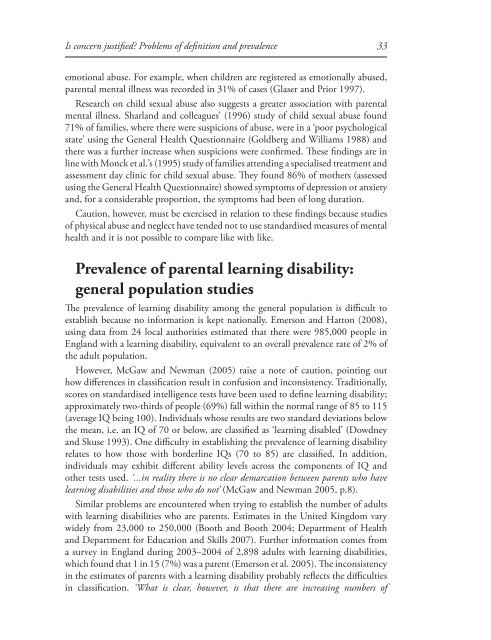Children's Needs â Parenting Capacity - Digital Education Resource ...
Children's Needs â Parenting Capacity - Digital Education Resource ...
Children's Needs â Parenting Capacity - Digital Education Resource ...
You also want an ePaper? Increase the reach of your titles
YUMPU automatically turns print PDFs into web optimized ePapers that Google loves.
Is concern justified? Problems of definition and prevalence 33emotional abuse. For example, when children are registered as emotionally abused,parental mental illness was recorded in 31% of cases (Glaser and Prior 1997).Research on child sexual abuse also suggests a greater association with parentalmental illness. Sharland and colleagues’ (1996) study of child sexual abuse found71% of families, where there were suspicions of abuse, were in a ‘poor psychologicalstate’ using the General Health Questionnaire (Goldberg and Williams 1988) andthere was a further increase when suspicions were confirmed. These findings are inline with Monck et al.’s (1995) study of families attending a specialised treatment andassessment day clinic for child sexual abuse. They found 86% of mothers (assessedusing the General Health Questionnaire) showed symptoms of depression or anxietyand, for a considerable proportion, the symptoms had been of long duration.Caution, however, must be exercised in relation to these findings because studiesof physical abuse and neglect have tended not to use standardised measures of mentalhealth and it is not possible to compare like with like.Prevalence of parental learning disability:general population studiesThe prevalence of learning disability among the general population is difficult toestablish because no information is kept nationally. Emerson and Hatton (2008),using data from 24 local authorities estimated that there were 985,000 people inEngland with a learning disability, equivalent to an overall prevalence rate of 2% ofthe adult population.However, McGaw and Newman (2005) raise a note of caution, pointing outhow differences in classification result in confusion and inconsistency. Traditionally,scores on standardised intelligence tests have been used to define learning disability;approximately two-thirds of people (69%) fall within the normal range of 85 to 115(average IQ being 100). Individuals whose results are two standard deviations belowthe mean, i.e. an IQ of 70 or below, are classified as ‘learning disabled’ (Dowdneyand Skuse 1993). One difficulty in establishing the prevalence of learning disabilityrelates to how those with borderline IQs (70 to 85) are classified. In addition,individuals may exhibit different ability levels across the components of IQ andother tests used. ‘...in reality there is no clear demarcation between parents who havelearning disabilities and those who do not’ (McGaw and Newman 2005, p.8).Similar problems are encountered when trying to establish the number of adultswith learning disabilities who are parents. Estimates in the United Kingdom varywidely from 23,000 to 250,000 (Booth and Booth 2004; Department of Healthand Department for <strong>Education</strong> and Skills 2007). Further information comes froma survey in England during 2003–2004 of 2,898 adults with learning disabilities,which found that 1 in 15 (7%) was a parent (Emerson et al. 2005). The inconsistencyin the estimates of parents with a learning disability probably reflects the difficultiesin classification. ‘What is clear, however, is that there are increasing numbers of
















